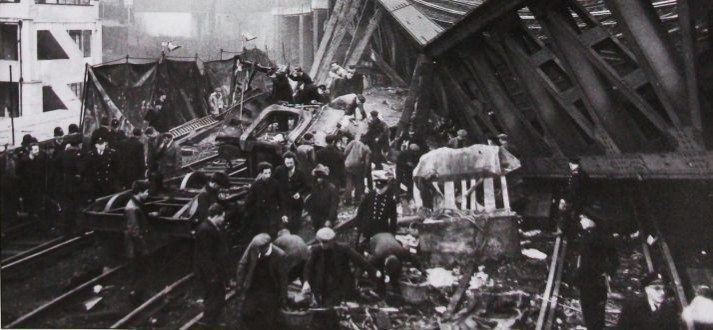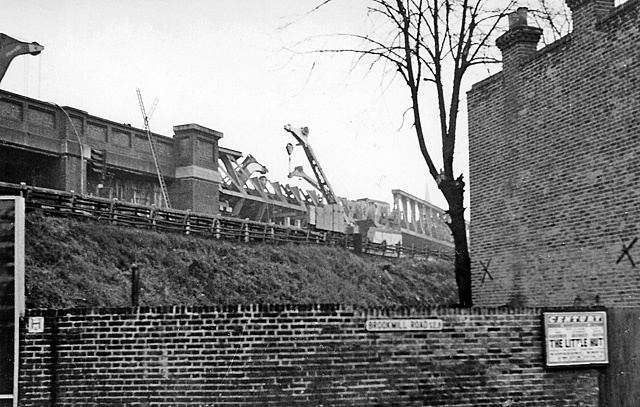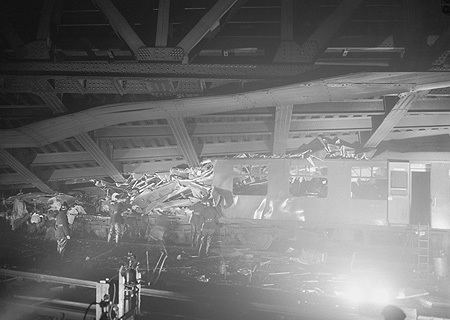Date 4 December 1957 Operator British Rail Trains 2 | Country England Total number of deaths 90 Injuries 173 | |
 | ||
Rail line South Eastern Main Line Similar Harrow and Wealdsto, Hither Green rail crash, Ilford rail crash, Wembley Central rail crash, Spa Road Junction rail crash | ||
The Lewisham rail crash occurred on the Lewisham by-pass line in London at about 6:20 pm on 4 December 1957. In dense fog, an electric train to Hayes stopped at a signal under a bridge and the following steam train to Ramsgate crashed into it, the collision causing the bridge to collapse onto the steam train. There were 90 fatalities and 109 people were detained in hospital. The bridge had to be cleared away and it was over a week before the lines under the bridge were reopened, and another month before the bridge had been rebuilt and traffic allowed over it.
Contents
- Collision
- Aftermath
- Coroners Inquest and Trial
- Civil action for psychological injury
- Report
- Legacy
- References

The driver of the Ramsgate train was acquitted of manslaughter charges after two trials. The Ministry of Transport report found that he had failed to slow after passing two caution signals so he was unable to stop at the danger signal, concluding that an automatic warning system would have prevented the collision.

Collision

On the evening of 4 December 1957 there was dense fog in the London area and trains were running late. The 5:18 pm Charing Cross to Hayes, comprising electric multiple units totalling 10 cars and carrying nearly 1,500 passengers, stopped at a danger signal at Parks Bridge Junction on the Lewisham by-pass line, under a bridge carrying rail tracks over the line. Trains were running out of order because of the fog and the Parks Bridge Junction signalman wished to speak to the driver by the telephone at the signal to confirm the train's identity and destination. At approximately 6:20 pm it was struck from behind by a train from Cannon Street to Ramsgate via Folkestone, consisting of a steam locomotive hauling 11 coaches carrying about 700 passengers and travelling at about 30 miles per hour (48 km/h). The collision threw the tender and leading coach off the track, dislodging a pier of the bridge, causing it to fall and crush two coaches. Two minutes later a train due to pass over the bridge stopped short, although its leading coach was tilted.

There were 90 fatalities and a large number of people were taken to hospital, of whom 109 were admitted.
Aftermath
The first emergency response arrived at 6:25 pm with the Fire Brigade, Ambulance and Police being assisted by doctors and nurses. Help was accepted from the Salvation Army, the Women's Voluntary Service, St John Ambulance Brigade and local residents. By 10:30 pm all of the injured had been taken to hospital.
All four of the running lines under the bridge and the two over it were blocked. At St Johns station just north of the bridge the North Kent line diverges, but this needed to be closed and the traction current switched off during the rescue. An emergency timetable started at 6:10 am the following morning, with local trains travelling through Lewisham, avoiding the accident, and main-line services diverted to Victoria, another London terminus.
At 4:00 pm on 9 December the trains and the fallen bridge had been cut up and removed. The track then had to be relaid and the lines under the bridge were reopened at 5:00 am on 12 December. A temporary bridge was builtimage and the overhead line was reopened at 6:00 am on 13 January.
Coroner's Inquest and Trial
The jury at the inquest declared by majority that the deaths were due to gross negligence but the coroner rejected the verdict and substituted one of accidental death. The driver of the Ramsgate train was then tried for manslaughter, but the jury could not reach a verdict. He was acquitted at a second trial.
Civil action for psychological injury
Mr Chadwick, a member of the public who assisted at the accident, successfully sued the British Railways Board for the "nervous shock" he experienced. The case, Chadwick v British Railways Board, an important precedent for 30 years, was partly overruled by White v Chief Constable of South Yorkshire 1999 2 A.C. 455.
Report
The Ministry of Transport report on the collision was published in 1958. Witnesses were interviewed, the visibility of the signals on the line examined, and tests showed no fault in the signalling equipment. The report found that the driver had not slowed for two caution signals, and applied the brakes only after the fireman had called to him that he had a danger signal. Although he had poor visibility of signals from the driver's seat, he did not cross over to see them, or ask the fireman to look for them.
The report concluded that an "Automatic Train Control of the Warning type" would have prevented the collision. Although installation had been agreed after the Harrow and Wealdstone rail crash in 1952, priority was being given to main-line routes controlled by semaphore signals. The poor visibility of signals from the steam locomotive, Battle of Britain class No. 34066, was mentioned with a recommendation that they be fitted with wider windscreens.
Legacy
The collapsed bridge was replaced by a temporary structure of military trestling, still in use.
A plaque at Lewisham railway station commemorates the accident.
